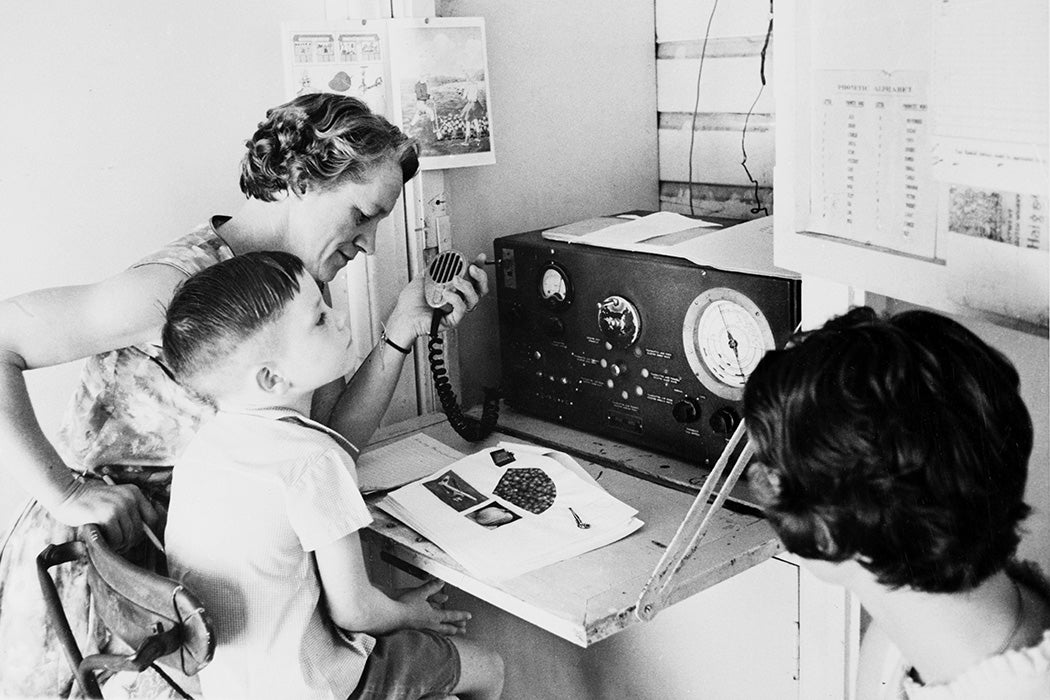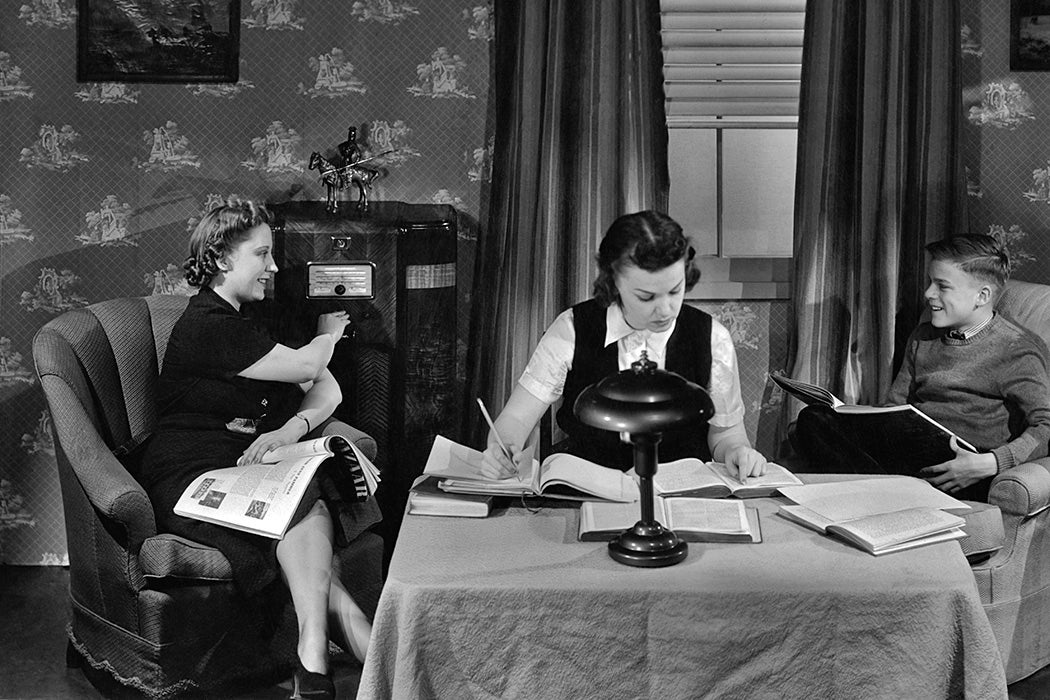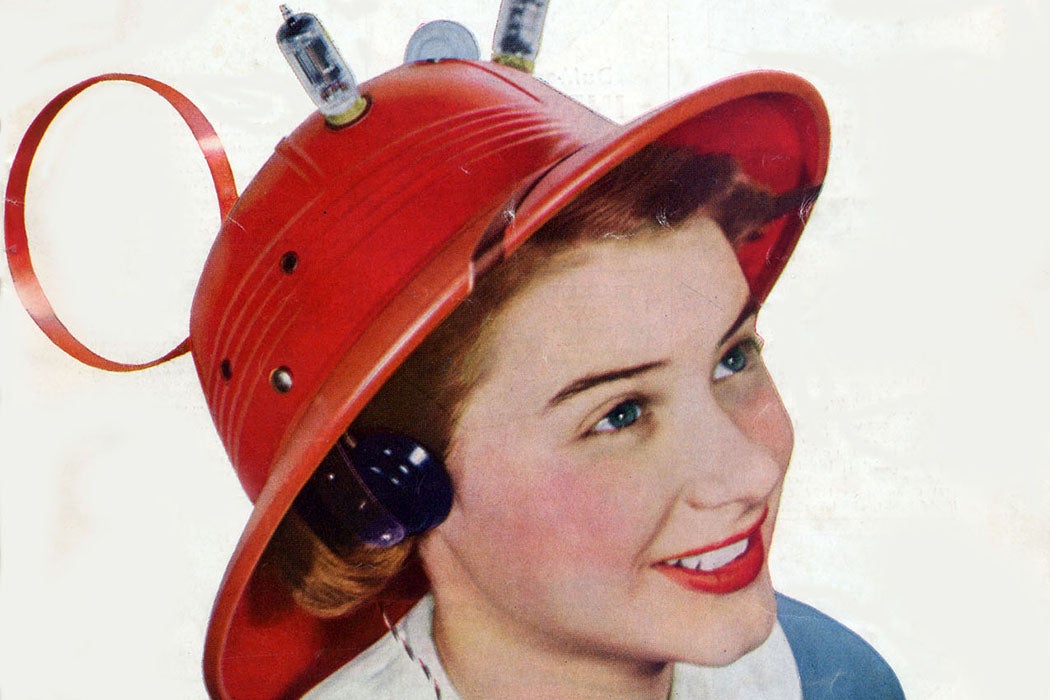It was mid-1922 and America was in the midst of the radio craze. Commercial broadcasting had emerged in a handful of cities in 1920, but at that time, few people had a receiving set—except for amateur radio operators, who knew how to build one. It wasn’t even called “radio” back then—newspapers referred to it as “radiophone” or “wireless telephone.” But only two years later, there were several hundred radio stations on the air, and you could purchase a radio in a store—although hobbyists still had fun trying to build their own, with varying degrees of success. Meanwhile, the word “radio” had become the common term for that wonderful new invention that everyone wanted in their home.
Today, we tend to take radio for granted; it is one of many ways to hear music or news or sports. But in 1922, radio was unique: it was the first mass medium to take people to an event in real time, and listeners were amazed by it. Suddenly, they could hear a popular orchestra coming through the radio set. Without leaving their home, they could listen to a baseball game, or an inspirational talk from a preacher; some stations even had the latest news headlines. In an era when traveling from one city to another could take hours (the popular Model T Ford had a top speed of 40-45 mph, and superhighways had not yet come along), listeners could travel by radio, hearing stations from distant cities. Before radio, only the wealthy could attend a concert featuring a famous vocalist, but now, anyone who had a receiving set could hear that singer’s music. And in an America that was still racially segregated, radio gave some musicians of color the opportunity to be heard by thousands of listeners. In magazines and newspapers, radio inspired “utopian hopes and bold predictions.” Writers referred to it as a cure for loneliness—especially for people living in rural areas or on the farm. It was also praised for helping the blind gain greater access to the world around them. More than one writer claimed radio would bring world peace, since everyone would unite around their favorite programs. And of course, as a sign of American progress, it was something no home should be without, not even the White House: President Harding was an enthusiastic radio fan, and had a set installed near his desk, so he could listen whenever he wanted to.
Early Concerns and Impact
Of course, as with any new invention, it did not take long for critics to express their concerns. Newspaper and magazine editors worried that radio listening would replace buying and reading their publications. Librarians worried that fewer people would want to read books. Teachers worried that kids might not do their own homework, or simply repeat what someone said on the radio. Musicians worried that people would no longer attend live concerts. Owners of baseball teams worried too—if the games were being broadcast, fans would no longer come out to the ballpark. A similar worry came from the clergy: if sermons were broadcast, wouldn’t church attendance fall? And social critics worried that conversation would suffer because everyone was busy listening to the radio. Meanwhile, inventor Lee de Forest spoke for many in hoping radio stations would avoid the “crude” dance music that young people liked, and encourage them to listen to “good music” (preferably classical and opera).
But while radio’s proponents and detractors debated, it was becoming more apparent that radio was having an impact on daily life. For example, in a 1924 article in Scientific American, Austin C. Lescarboura observed that radio made people more conscious about what time it was, since they didn’t want to miss their favorite programs. Meanwhile, people were still reading the newspaper, but they also stopped at the radio page, to find out what was on the air tonight and who was performing. (At first, many newspapers had regarded radio as competition and pretended broadcasting didn’t exist. But by 1923-1924, the vast majority of newspapers had learned to accommodate the radio fans by providing a page of news about what the local stations were doing. A similar phenomenon occurred with libraries: as interest in radio grew, more books about it were being written, and people went to the library to borrow them.)
Weekly Newsletter
As it turned out, most of the doom-and-gloom predictions about radio did not come to pass. But as its popularity grew, there was one other recurring question that nobody seemed able to answer: was radio destined to be mainly an entertainment medium or could it have other uses? Certainly a lot of the fan mail to the radio stations expressed appreciation for the music and the sporting events. But in the pages of many radio magazines, writers debated whether just providing entertainment was enough. (You can read their articles on a wonderful database called WorldRadioHistory.com, where you will find such magazines as Radio Digest, Radio News, Radio World, Radio Broadcast, Radio in the Home, Radio Age, and Popular Radio.) While many of the writers were pleased by the wide range of programs, some believed radio had not provided enough educational broadcasts.
Unfortunately, few early stations had the budget to produce them; prior to the mid-1920s, commercials were frowned upon by the Department of Commerce (which supervised broadcasting at that time). With minimal revenue coming in, many stations operated on a shoestring, and relied on volunteers. The best they could offer was occasional informative talks by local guest experts. A growing number also inaugurated children’s programs, featuring a “Story Lady” who read bedtime stories to the little ones; some of the stories were about travel or nature or famous people. By 1923, radio stations like KQV in Pittsburgh, WJZ in Newark, New Jersey, and KYW in Chicago expanded the “Story Lady” idea into programs for older children and their parents: on these once-a-week broadcasts, literature, poems, and selections from newly arrived library books were read.
The Birth of Educational Radio
Meanwhile, a few universities decided to try their hand at broadcasting educational talks, and they began collaborating with local radio stations. As early as April 1922, Tufts College (today Tufts University) in Medford, Massachusetts, utilized greater Boston station WGI to broadcast a series of lectures from Tufts professors. The topics included the study of architecture, modern drama, world events, and economics. A lecture about music appreciation even included selections from the Tufts College Glee Club. According to Radio Digest, the purpose of the lectures was to “bring knowledge within the reach of every man, woman, and child in the country.” And Tufts was not alone in this effort: plans were underway to provide similar educational talks from faculty members at the University of Michigan, using station WWJ in Detroit. There were also some universities that operated their own stations. One was WHA, at the University of Wisconsin at Madison, which sometimes broadcast short talks from professors. Ohio State University also had a station, then called WEAO (today WOSU) and its professors too did some broadcasts. Because audiotape had not yet been invented, we have no idea how any of these programs sounded; but since it was an era when relatively few people attended college, we can surmise that the listeners were impressed. It wasn’t every day when they had the opportunity to learn something new from a professor.

Although these innovative colleges were doing a version of what we today would call “distance education” or “remote learning,” none of the academic journals seemed to notice. It would not be until 1924 when any academic journal mentioned the impact of radio broadcasting at all. One of the earliest to do so was a new journal from the George Peabody College for Teachers in Nashville, Tennessee. The Peabody Journal of Education, which had made its debut in July 1923, published a short article in the March 1924 issue, called “When ‘Professor’ Coolidge Lectured,” and it addressed something else radio was becoming known for: letting the public hear the voices of famous news-makers, including the President himself. In the article, the anonymous author expressed amazement at being able to “listen in” from hundreds of miles away as the president gave an address to Congress. This was one reason why the author believed radio had great potential as an educational tool—the medium’s ability to carry the words of important speakers directly into any classroom. Another article, from Ohio State University’s College of Education, was published in the Educational Research Bulletin in November 1925; it made similar observations. (The Bulletin too was among the newer journals, having made its debut in 1922.) This article was written by the pseudonymous E.J.A., who in reality was a well-known professor of education named Ernest James Ashbaugh. Previously the director of the Extension Division at the University of Iowa, he was now at Ohio State, as the Assistant Director of the Bureau of Educational Research. Ashbaugh agreed that the most common use for radio was still entertainment, but he was convinced that radio was becoming an increasingly valuable educational resource.
However, while he noticed that more teachers were using radio in the classroom, he wondered why there was still no unified plan, no “organized way” for teachers to utilize what was on the air. While certain school systems, like New York City, began producing educational broadcasts in 1924, other school districts made no use of radio at all. Not only was there no consistency, but there was no guidance about what we today would call “best practices.” Nor was there any reliable way to measure the effectiveness of the broadcasts.
It wasn’t until the late 1920s when Ashbaugh’s hope for a consistent national policy was finally addressed. It happened as a result of the Radio Act of 1927, which created the Federal Radio Commission (FRC) to oversee broadcasting. To receive a radio license from the FRC, station owners needed to demonstrate that they were operating in the “public interest.” Although that concept was never clearly defined, many station owners came to believe educational programs were one way to fulfill the FRC’s requirement.
In 1927-1928, a large research study was undertaken by the Payne Fund, an educational foundation. Superintendents and principals in hundreds of American schools were surveyed; they were asked their views on the value and importance of educational broadcasting. The responses were so positive that it inspired the Ohio Department of Education, along with Ohio State University, to make educational broadcasts more widely available. The Ohio legislature allocated $20,000 for the project, and the Ohio School of the Air was born; it debuted on January 7, 1929, operating four days a week, from 1:30 to 2:30 p.m. By the end of 1929, more than 230 Ohio communities had installed radios in their schools so that students could hear the daily programs, broadcast from Ohio State’s WEAO in Columbus and powerful Cincinnati commercial station WLW. (Being rebroadcast by WLW meant the programs could be heard in numerous other states.)

Having a budget enabled the Ohio School of the Air to produce top-quality programs that were interesting for students, and easy for teachers to build discussions around—there were even sample lesson plans and suggested readings provided. It also meant being able to hire talented professionals to read poetry or perform Shakespearean plays, native speakers to give French lessons, and experienced musicians for music appreciation (a major plus for schools too small to have their own orchestras or glee clubs). And students were not just passive listeners: the lessons often included talks by well-known experts, like aviators, or doctors, or scientists, or journalists, or even the governor, who answered questions the students had asked.
Thanks to JSTOR, we can read firsthand accounts from the Ohio School of the Air’s founding program director Ben H. Darrow; John (J. L.) Clifton, director of education for the state of Ohio; and some of the professors who were involved with evaluating the courses, like Frederick H. Lumley. It is also fascinating to read about other equally well-funded educational programs, like the American School of the Air, which debuted on the Columbia Broadcasting System (later known as CBS) in February 1930, with William C. Bagley of Teachers College at Columbia University in charge, and Alice Keith, a former Cleveland public schools teacher, and an experienced broadcaster, as the supervisor of programs. In a November 1930 article, Keith offered advice to anyone developing an educational program: it should be entertaining, not too long, and tie in with some actual work the students can do. After the broadcast, the teacher should discuss the content. And it was best for students to listen in their classroom, rather than in an auditorium. Among the most popular features the American School of the Air offered were dramatized versions of historical events.
Other educational programs included the RCA Music Education Hour, which debuted on the National Broadcasting Company (later known as NBC) in 1928, with well-known conductor and music educator Walter Damrosch in charge; and the University of Chicago Roundtable, which debuted in 1931. (Created by NBC’s education director Judith Waller, it specialized in discussions of world events.) All of these programs received positive reviews in newspapers and magazines, and educators nationwide expressed their appreciation for so much useful material. There was still some debate about how much impact these programs were having (outcomes assessment was very new); but even those who had been skeptical had to admit that radio now played an important role in education—not as a substitute for good teachers, but as “a very effective supplement to school instruction.” And if used wisely, as Ben H. Darrow of the Ohio School of the Air advised in 1929, radio, television, and future technologies would serve “…not to distract, but to energize study, to motivate, to add joy to the journey.”







